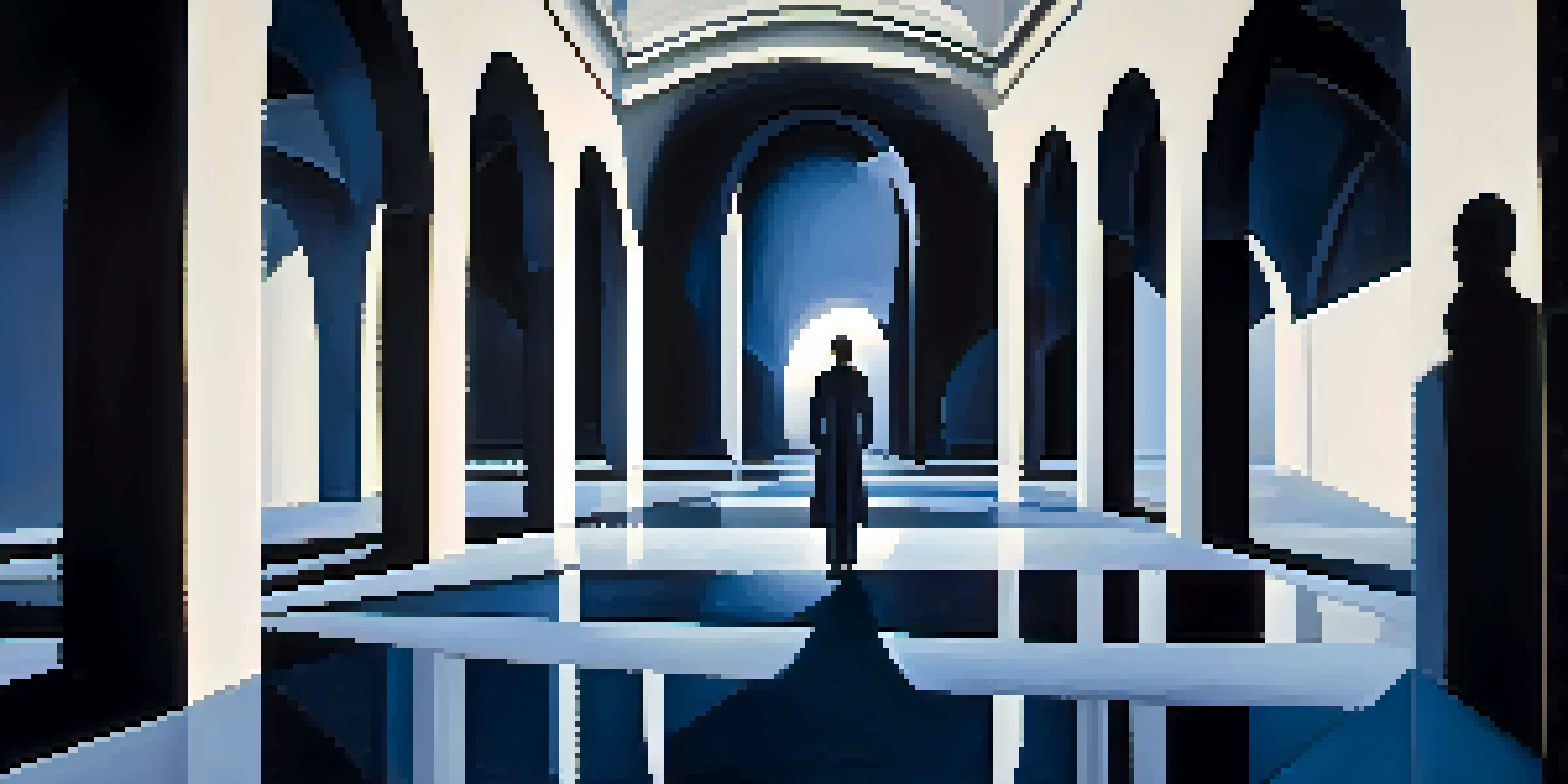Understanding Formalism in Film: A Comprehensive Overview

What is Formalism in Film? A Brief Introduction
Formalism in film is an approach that emphasizes the aesthetic aspects of cinema. Rather than focusing solely on narrative and character, formalism looks at how visual and auditory elements shape our understanding of a film. It’s like appreciating a painting not just for its subject but for its colors, lines, and textures.
The camera is an instrument that teaches people how to see without a camera.
This approach can be seen in various artistic movements, where the form itself becomes a crucial part of the message. For instance, think of a film like 'The Cabinet of Dr. Caligari,' where the expressionistic set design and stark contrasts create a disorienting atmosphere. Here, the style is not merely a backdrop but a character in its own right.
In essence, formalism invites viewers to engage with a film on a deeper level, appreciating the craftsmanship behind every shot, edit, and sound. This perspective allows for a richer viewing experience, making us aware of the artistry that goes into filmmaking.
Key Characteristics of Formalist Films
Formalist films often feature distinct visual styles, emphasizing composition, color, and movement. This can manifest in the use of unusual angles, dramatic lighting, or vibrant color palettes that draw attention to the film's artistic qualities. A great example is Wes Anderson's work, where symmetrical compositions and pastel colors create a unique aesthetic.

Another characteristic is the manipulation of time and space. Formalist filmmakers may employ techniques like slow motion, fast cuts, or non-linear storytelling to enhance the viewing experience. These choices not only serve to tell a story but also to evoke emotions and provoke thought.
Formalism Emphasizes Aesthetic Value
This approach focuses on how visual and auditory elements shape our understanding of a film, inviting deeper engagement with its artistry.
Lastly, sound plays a vital role in formalist cinema, often used creatively to complement visual elements. Sound design can build atmosphere or create dissonance, adding layers to the narrative. In films like 'Birdman,' the continuous drum score heightens the tension and immerses viewers in the protagonist's chaotic world.
Historical Context: Formalism's Roots in Cinema
The roots of formalism can be traced back to early 20th-century cinema, particularly in movements like German Expressionism and Soviet Montage. These movements sought to break traditional narrative structures and explore new ways of visual storytelling. For instance, Eisenstein's 'Battleship Potemkin' is renowned for its innovative editing techniques that emphasize emotional impact over straightforward storytelling.
Film is a social process, and the film itself is a social document.
As cinema evolved, so did formalist approaches, influenced by various artistic movements, including Surrealism and Modernism. These styles prompted filmmakers to experiment with form and challenge viewers' perceptions. This is evident in films such as 'Un Chien Andalou,' where the disjointed narrative forces audiences to engage with the film on a more abstract level.
Over the decades, formalism has continued to shape cinema, with filmmakers pushing boundaries to explore visual language. Today, many contemporary directors still draw from these early influences, demonstrating the lasting impact of formalism on the art of filmmaking.
Notable Formalist Filmmakers and Their Works
Several filmmakers are celebrated for their formalist techniques, each bringing a unique style to the table. Directors like Stanley Kubrick and Alfred Hitchcock are often cited for their meticulous attention to detail in visual composition. Kubrick’s '2001: A Space Odyssey' is a prime example, where every frame is crafted with precision to evoke awe and contemplation.
Another influential figure is Andrei Tarkovsky, known for his poetic and philosophical approach to cinema. His films, such as 'Stalker,' utilize long takes and rich imagery to delve into existential themes. Tarkovsky’s work encourages viewers to reflect on the nature of time and existence, showcasing how form can enhance thematic depth.
Notable Filmmakers Embrace Formalism
Directors like Stanley Kubrick and Alfred Hitchcock are recognized for their meticulous visual composition, enhancing thematic depth through formalist techniques.
In more recent years, filmmakers like David Lynch and Christopher Nolan have embraced formalism, creating films that challenge conventional storytelling. Lynch's 'Mulholland Drive' is a labyrinthine experience that plays with narrative structure, while Nolan’s 'Inception' uses intricate visual effects to explore the nature of dreams and reality.
The Role of Cinematography in Formalist Films
Cinematography is a cornerstone of formalism, as it shapes the viewer's experience through visual storytelling. The choice of camera angles, lighting, and framing can dramatically alter the perception of a scene. For instance, a low-angle shot can make a character appear powerful, while a high-angle shot might evoke vulnerability.
Moreover, the use of color in cinematography can convey emotions and set the tone. Think of the vibrant reds and greens in 'The Grand Budapest Hotel,' which not only provide a visual feast but also contribute to the film's whimsical atmosphere. Such choices are integral to how a story is perceived and felt.
Additionally, movement in cinematography—whether through tracking shots, handheld techniques, or static frames—affects the pacing and rhythm of a film. Directors often use these techniques to create tension or intimacy, guiding viewers through the emotional landscape of the narrative.
Editing: The Backbone of Formalist Expression
Editing is crucial in formalist films, as it dictates the rhythm and flow of the narrative. Techniques like jump cuts, cross-cutting, or montage can create a dynamic viewing experience that keeps audiences engaged. For instance, the rapid editing in 'Requiem for a Dream' mirrors the characters' spiraling descent into addiction, heightening emotional impact.
In formalist cinema, the editing style is often as expressive as the visuals themselves. Directors may choose to disrupt conventional continuity, forcing viewers to pay attention to the film's structure. This can create a sense of disorientation, inviting audiences to reflect on the narrative's deeper meanings.
Cinematography Shapes Viewer Experience
The choice of camera angles, lighting, and color in formalist films significantly influences how a scene is perceived and felt by the audience.
Furthermore, the pacing established by editing can influence how a story unfolds. A slowly paced edit can build tension and anticipation, while fast cuts might convey chaos or urgency. This control over time and perception is a hallmark of formalism, showcasing the artistry behind the scenes.
Impact of Formalism on Modern Filmmaking
The influence of formalism continues to resonate in modern filmmaking, shaping how stories are told and experienced. Contemporary directors often draw from formalist techniques to create visually stunning films that challenge traditional narratives. This has led to an appreciation for the artistic aspects of cinema, encouraging audiences to engage with films on a more analytical level.
Streaming platforms have also provided a space for formalist films to thrive, allowing diverse voices and innovative styles to reach wider audiences. Films that prioritize form and aesthetics can now find their place in popular culture, sparking discussions around visual storytelling and its significance.

Moreover, as technology evolves, filmmakers have more tools at their disposal to experiment with form. From virtual reality to advanced CGI, the possibilities for visual expression are expanding, giving rise to new formalist trends. As we look to the future, it’s clear that formalism will continue to play a vital role in the evolution of cinema.